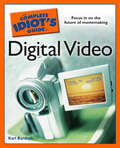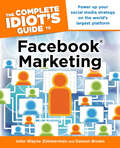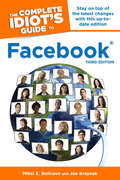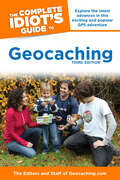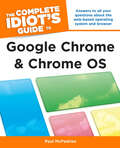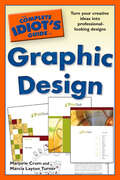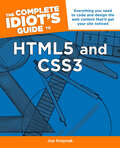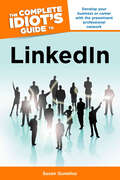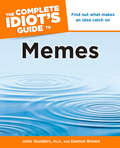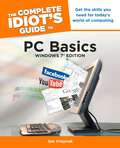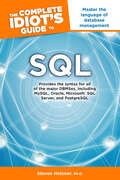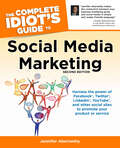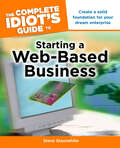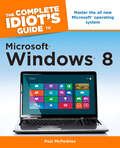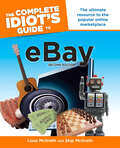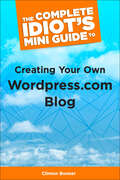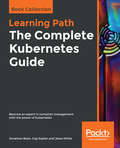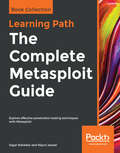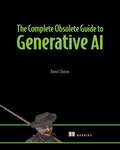- Table View
- List View
The Complete Idiot's Guide to Digital Video
by Karl BardoshJoin the digital revolutionWith the availability and affordability of digital movie-making equipment, it&’s now easier than ever for aspiring filmmakers to create the great movie they&’ve always wanted to make. From information on creating mini-films on a PDA to making low-budget, full-length digital movies, The Complete Idiot&’s Guide® to Digital Video provides all the information you need to turn your idea into reality.• A must-read for every film student or novice• Covers all aspects of production, from casting and directing to light and sound to digital editing• Includes 8–page, 4–color insert• Up–to–date recommendations on equipment and software• Clear, easy-to-follow instructions and guidance, as well as all the practical, artistic, and technical &“step–by–step&” advice that only an experienced writer/director can offer
The Complete Idiot's Guide to Facebook Marketing: Power Up Your Social Media Strategy on the World’s Largest Platform
by Damon Brown John Wayne ZimmermanCovers all aspects including Facebook Marketplace, Facebook Places, and Facebook Deals
The Complete Idiot's Guide to Facebook, 3rd Edition: Stay on Top of the Latest Changes with This Up-to-Date Edition
by Joe Kraynak Mikal E. BelicoveFacebook is by far the most popular social networking site, but it is not as user-friendly as the service would like people to think. It leaves many users scratching their heads over even the most fundamental features, such as the difference between their Wall and their News Feed. And Facebook's help system is woefully inadequate. The Complete Idiot's Guide® to Facebook, Third Edition, gets readers registered and touring Facebook in the very first chapter and never lets up as it reveals the features that have made Facebook so amazingly popular. Users discover how to:- Flesh out and protect the all new personal profile- Track down long lost friends, family members, and classmates- Communicate via status updates, email, and chat- Share photos and video- Make the best use of the new Timeline feature- Take advantage of Facebook's new location-based functionality- Schedule real world get-togethers and send out invitations- Share common interests in groups- Play games- Understand Facebook's dizzying array of privacy options that dictate who sees one's content- Buy and sell stuff in the Facebook Marketplace, and more.Readers also learn how to tap the power of Facebook for more than simply personal use-such as personal branding; marketing a business, product, service, or non profit; or promoting a worthy cause.
The Complete Idiot's Guide to Geocaching, 3rd Edition: Explore the Latest Advances in This Exciting and Popular GPS Adventure
by Editors & Staff Geocaching.comGeocaching has steadily grown into a fun and enduring outdoor adventure and with the popularity of GPS units and the development of applications for nearly all of the most popular smartphone platforms, it has become an adventure that's available to pretty much anyone. In The Complete Idiot's Guide® to Geocaching, Third Edition, the editors and staff of Geocaching.com open the world of geocaching up to a much broader audience and take the reader through all of the core essentials for caching including how to play, tips and tricks for finding and placing caches, variations on traditional caching, and much more. In addition, the reader can learn about exciting new changes to the game and the new GPS-enabled games that will take cachers to an entirely new level of fun and adventure.
The Complete Idiot's Guide to Google Chrome and Chrome OS
by Paul McFedriesA nontechnical manual for groundbreaking technology The Complete Idiot's Guide® to Google Chrome OS presents readers with a clear overview of Google's free operating system—targeting users of netbook computers and allowing them to work primarily on the web—including how to send email, work with pictures, save and manage files, use common office applications as well as more specialized programs, and deal with problems. • Available day-and-date with the software • Chrome OS will be free, making it very competitive with Windows 7 • Google boasts that Chrome OS will start up and get the user onto the web in a few seconds, without having to contend with viruses, malware, and security updates
The Complete Idiot's Guide to Graphic Design: Turn Your Creative Ideas into Professional-Looking Design
by Marcia Layton Turner Marjorie CrumIf you can dream it, you can design it Whether your goal is to design your own marketing materials, launch a visually compelling blog, or just have some fun creating your own CD covers, The Complete Idiot&’s Guide® to Graphic Design is your one-stop reference. Presented in an intuitive, accessible format, here are the fundamental elements of design and design principles, as well as instruction on how to apply those elements and principles to a variety of projects. • Covers art supplies, software, concept development, reproduction needs, and much more • Sample projects include business cards, print and web ads, and graphic T-shirts • Follows the success of other titles aimed at the aspiring artist, including the Complete Idiot&’s Guide® titles on digital photography, drawing, and manga
The Complete Idiot's Guide to HTML5 and CSS3: Everything You Need to Code and Design the Web Content and That’ll Get Your Site
by Joe KraynakCreate dynamic, interactive websites with HTML5 and CSS3. HTML5 and CSS3 are the newest revisions of the primary standards for structuring and styling web content—major updates that enable designers and developers to streamline source code and publish more dynamic, interactive content without having to learn complex scripting languages. The Complete Idiot's Guide® to HTML5 and CSS3 provides both new and existing web developers the tools they need to code and design the web content that people increasingly expect to experience when they surf the web. Even better, you learn HTML5 and CSS3 in the context of building a website with a content management system (CMS), such as WordPress. You can then apply your knowledge of HTML5 and CSS3 to customize your site, instead of starting from scratch. You discover how to: • Design and maintain a website using web-based tools instead of a complicated HTML editor. • Code pages properly using the new HTML5 structure tags. • Embed audio and video using the new HTML5 tags. • Apply a CSS theme to format pages, and customize the theme using CSS3 styles. • Use CSS3 to round box corners and make images and backgrounds more or less transparent. • Take full advantage of new CSS3 transformation and animation features to animate objects on a page, create image rollovers, and build your own drop-down menus. • Test and fine-tune your site to make it load faster and look just right. • Perform an SEO audit of your site and keyword-optimize your site's content. The Complete Idiot's Guide® to HTML5 and CSS3 features: • 16-page color insert • HTML5 Quick Reference • CSS3 Properties and Values Quick Reference • HTML Special Characters and Symbols Quick Reference • Speak Like a Geek Glossary From the Author Although this book focuses primarily on HTML5 & CSS3, it presents these topics in the context of building a web site. When you're first getting started, building a site from scratch using only HTML and CSS can be overwhelming. You're usually better off starting with a content management system (CMS), such as WordPress, and a pre-designed theme. You can then use your knowledge of HTML5 and CSS3 to customize your site, instead of starting from scratch. This approach gets your site up and running as quickly as possible and allows you to learn more at a more comfortable pace.
The Complete Idiot's Guide to LinkedIn: Develop Your Business or Career with the Preeminent Professional Network
by Susan GuneliusDevelop your business or career with the pre-eminent professional network Most people who are new to LinkedIn don't intuitively recognize the potential of the site when it comes to promoting a business, finding a job/project (or being found for one), or raising money for a business venture. The Complete Idiot's Guide® to LinkedIn goes beyond the usual "how to set up and account" and "create a profile" to help readers become LinkedIn super-users and get the most out of the website based on their individual goals. The book provides new users with clear and detailed guidance on: • Filling out the various parts of the LinkedIn profile, customizing it to meet specific professional goals • The right and wrongs ways of doing things on LinkedIn-especially helpful to those used to Facebook• Finding the right people, making the right introductions, and growing and managing networks • Finding and communicating with LinkedIn Groups to help achieve individual business goals • Specific suggestions for using LinkedIn to find a job, market a business, raise capital, and increase sales
The Complete Idiot's Guide to Memes: Find Out What Makes an Idea Catch On
by Damon Brown John GundersThe ways of memes. Memes are "viruses of the mind"—symbols, ideas, or practices that are transmitted through speech, gestures, and rituals. Understanding how symbols like the peace sign or ad slogans like "Where's the beef?" or viral videos become part of our common culture has become a primary focus of sales and marketing companies across the globe. The Complete Idiot's Guide® to Memes explains how memes work, how they spread, and what memes tell us about how we make sense of our world. • First book to cover all types of memes, including viral memes in the digital age • Features the Most Influential Memes in History and the Ten Biggest Internet Memes
The Complete Idiot's Guide to PC Basics, Windows 7 Edition
by Joe KraynakDiscover how to do just about anything with your Windows 7 PC The Complete Idiot's Guide® to PC Basics, Windows 7 Edition shows you how to do practical and fun stuff with your PC, including . . . Basics • Navigate and personalize Windows 7 • Manage disks, files, and folders • Install and uninstall programs • Use office applications, including a word processor and spreadsheet • Manage your personal finances • Get up and running with email Fun Stuff • Manage your digital photos and share them online • Transform a collection of photos into a movie and burn it to a DVD • Download music and transfer it to your MP3 player or CDs • Get connected with friends, family, and old school chums on Facebook • Tweet on Twitter • Discover cool features on Google you never knew existed • Watch and share video on YouTube • Find deals on eBay and other shopping sites • Create your own website or blog for free • Make free or really cheap phone calls all over the world with Skype For power users • Set up a home or small-business network • Protect your computer from viruses and other online threats • Upgrade and troubleshoot your PC From the Author You don't need to be a mechanic to drive a car, and you don't need to be a technician to use a computer. This book puts you in the driver's seat and shows you how to get where you're going with your computer, its software, and the Internet. Whether you want to manage your finances or your photos, connect with family and friends on Facebook, or buy and sell stuff on eBay, this book provides the step-by-step guidance that shows you how to do it.
The Complete Idiot's Guide to Pinterest Marketing: Tap into Key Markets Using the Hottest Social Media Image-Sharing Site
by Barbara Boyd Christine MartinezPinterest is a social media site that enables users to create online pinboards of compelling images they find online by "pinning" the images and curating them into various categories. It has exploded into American consciousness with big media attention and exponential growth-most notably reaching 10 million unique monthly visitors more quickly than any social media site in history. The vast majority of early devotees have been women of higher income between the ages of 25 and 49, and the images they pin frequently fall into the categories of clothing, crafts, food, and home décor. This represents a significant opportunity for companies and brands whose products are targeted to this market; however, Pinterest has value far beyond its initial popular use. Companies large and small are hearing the hype and hoping to get an early start with a site that shows signs of continued growth and influence. The Complete Idiot's Guide® to Pinterest Marketing helps small business owners as well as marketing experts at larger companies get on the Pinterest bandwagon and learn how to use this exciting new phenomenon to increase online exposure for their products, strengthen their online presence, and connect with customers in a place where they are now flocking. In it, readers learn how to: Use the basic features of Pinterest, including setting up an account, creating boards, and pinning images. Develop a Pinterest marketing strategy and integrate it with other online and offline presences. Project a brand voice onto Pinterest through strategic pinning and writing compelling pin copy. Create pins that get repinned. Grow a following organically and understand the importance of whom a brand follows. Engage an audience through contests, collaborative boards, and more. Determine who in the organization will pin, or whether to outsource it. Gauge and quantify the success of a brand's marketing efforts on Pinterest.
The Complete Idiot's Guide to SQL: Master the Language of Database Management
by Steven Holzner• Provides a practical overview of the most common database management tasks for those who need to manage data
The Complete Idiot's Guide to Selling Your Crafts on Etsy
by Marcia Layton TurnerEtsy is a wildly popular website where crafters and craftsmen alike have discovered a portal where they can market and sell their handmade wares—literally around the globe. Any successful Etsy seller will tell you the difference between a successful Etsy storefront and the storefront that gets lost in the mix often boils down to the tricky details. The Complete Idiot&’s Guide® to Selling Your Crafts with Etsy is written by someone who has proven selling success on Etsy and knows the tricks that will get a storefront noticed—and wares shipping out the door. From having the right keywords in place for optimum searchability, to creating an attractive storefront that will create return customers and loads of traffic, The Complete Idiot&’s Guide® to Selling Your Crafts with Etsy will help you learn the tricks of the trade and help you build the successful Etsy business you have always wanted.
The Complete Idiot's Guide to Social Media Marketing, 2nd Edition
by Jennifer AbernethyThe Complete Idiot's Guide® to Social Media Marketing, Second Edition, covers cutting-edge techniques for small and large businesses alike. Ask the AuthorQ: How has social media marketing changed business and personal lives?A: The playing field has been leveled for business. No longer do you need a 6 or 7 figure budget to reach people around the country or globe for that matter. Personally, many lives have been affected. Many people more connected, businesses have grown because of the connections, TV and singing careers have been launched, money has been raised for charity, books have been marketed and purchased, and so on.Q: What has been the most challenging part of utilizing social media?A: I think the learning curve. With all of these sites . . . they come with no directions and no LIVE phone number.Q: What has worked the best and worst thus far?A: Facebook because of it&’s broad reach really has worked for me, but many would argue that YouTube works the best; particularly since it is the search engine of choice with the 11–34 age group.Q: How can a person searching for a job use social media marketing?A: So many ways. . . . They need to be on LinkedIn with a professional looking profile, photo, and contact information. They could also utilize video to begin sharing their expertise. Candidates need to stand out in a crowd of millions so if they say . . . sent in a video introducing themselves and a video follow up email . . . that would wow them!Q: What is the newest thing since Twitter?A: I believe companies and individuals are starting to utilize audio for creating their own iTunes channel, and also location-based social media like FourSquare. I personally, am not sold on location based services as of yet from a safety point of view, but for retailers it can be a good thing. I believe video is going to explode in popularity in 2011 for the 35+ market as well. They just need to get comfortable being on camera!
The Complete Idiot's Guide to Starting a Web-Based Business
by Steve SlaunwhiteThe web-based basics! Aspiring web entrepreneurs will find here everything they need to know about starting and running their own small-scale online business. Whether they intend to sell goods, services, subscriptions, or advertising, this book provides them with the specific nuts and bolts of planning, designing, building, hosting, marketing, and operating their online businesses. • The Complete Idiot's Guide® to Starting Your Own Business has over a quarter million copies sold in five editions • 1.6 million web-based businesses in the U.S., a $175 billion market in 2007 • Online businesses benefiting from increasing number of Internet users—with increased traffic for subscription, advertising, and affiliate program revenue
The Complete Idiot's Guide to Using Your Computer - for Seniors
by Paul McFedriesThe easiest way to get what you want from your computer With The Complete Idiot's Guide® to Using Your Computer - For Seniors, getting started with your computer couldn't be easier.This guide is focused on all the activities you want to learn how to do including how to set up and use your computer and email, browse and search online and protect your computer against viruses and spam. Also learn how to work with photos, shop online, use social networks, and play games, music and films so you can get the most out of your computer. You'll also find out how to seek help and troubleshoot common problems.With lots of helpful visuals, oversized type and absolutely everything you need to know to use a computer with ease, The Complete Idiot's Guide® to Using Your Computer - For Seniors is the perfect companion to have on hand.
The Complete Idiot's Guide to Windows 8: Master the All New Microsoft Operating System
by Paul McFedriesMicrosoft® Windows® 8 is designed to mesh users' digital lives seamlessly—from desktop to phone to tablet—by utilizing a look and feel that give users a new Windows experience. However, with all of this change comes new features that may catch old-school Windows users off guard. In The Complete Idiot&’s Guide® to Microsoft® Windows® 8, veteran tech writer Paul McFedries uses his friendly style and wit to comfort experienced Windows users and newbies alike by explaining all the new features as well as the old, and helping everyone overcome trepidation about using this completely updated look to the most popular desktop operating system in the world. You will learn how to use new Windows 8 features, including tiles and the new home screen, how you can mesh your data with &“the cloud,&” and much more. And, when all else fails, McFedries teaches you how to easily and seamlessly toggle back to the &“old&” and familiar Windows look and feel, should the new experience prove to be a bit more change than desired.
The Complete Idiot's Guide to WordPress: Find Your Very Own Place in the Blogosphere
by Susan GuneliusTake advantage of the #1 blog publishing application. With more than 22 million users worldwide, WordPress is the #1 blog WordPress publishing application in the world. This guide provides users of both its hosted blogging service (WorldPress.com) and its self-hosted application (WordPress.org) with everything they need to know to create, customize, manage, and share their WordPress blogs with the world.
The Complete Idiot's Guide to eBay, 2nd Edition: The Ultimate Resource to the Popular Online Marketplace
by Lissa Mcgrath Skip McGrathExperts explain "the new eBay®" . . . eBay® users, new and experienced, also need a clear, convenient reference for optimum results. In this revised edition, readers will find:• Tips on how to set up an account• Buying and selling• Protecting one's identity• Finding the best deals• Making fast and profitable sales • Revised version includes major changes to eBay® as of July 2009, which change users' experience • Authors deeply involved and influential in the eBay® community, as sellers and educators • Tens of millions of people use eBay® every day and three quarters of a million people earn their living with it
The Complete Idiot's Mini Guide to Creating Your Own Wordpress.Com Blog
by Clinton BonnerLearn how to create your own Wordpress.com blog with this helpful guide! The Complete Idiot&’s Mini Guide to Creating Your Own Wordpress.com Blog gives user-friendly, step-by-step directions for building a successful blog. Topics covered include how to coding a blog theme, publishing posts, as well as installing additional beneficial applications.
The Complete Kubernetes Guide: Become an expert in container management with the power of Kubernetes
by Jonathan Baier Gigi Sayfan Jesse WhiteDesign, deploy, and manage large-scale containers using KubernetesKey FeaturesGain insight into the latest features of Kubernetes, including Prometheus and API aggregationDiscover ways to keep your clusters always available, scalable, and up-to-dateMaster the skills of designing and deploying large clusters on various cloud platformsBook DescriptionIf you are running a number of containers and want to be able to automate the way they’re managed, it can be helpful to have Kubernetes at your disposal. This Learning Path guides you through core Kubernetes constructs, such as pods, services, replica sets, replication controllers, and labels. You'll get started by learning how to integrate your build pipeline and deployments in a Kubernetes cluster. As you cover more chapters in the Learning Path, you'll get up to speed with orchestrating updates behind the scenes, avoiding downtime on your cluster, and dealing with underlying cloud provider instability in your cluster. With the help of real-world use cases, you'll also explore options for network configuration, and understand how to set up, operate, and troubleshoot various Kubernetes networking plugins. In addition to this, you'll gain insights into custom resource development and utilization in automation and maintenance workflows.By the end of this Learning Path, you'll have the expertise you need to progress from an intermediate to an advanced level of understanding Kubernetes.This Learning Path includes content from the following Packt products:Getting Started with Kubernetes - Third Edition by Jonathan Baier and Jesse WhiteMastering Kubernetes - Second Edition by Gigi SayfanWhat you will learnDownload, install, and configure the Kubernetes code baseCreate and configure custom Kubernetes resources Use third-party resources in your automation workflowsDeliver applications as standard packagesSet up and access monitoring and logging for Kubernetes clustersSet up external access to applications running in the clusterManage and scale Kubernetes with hosted platforms on Amazon Web Services (AWS), Azure, and Google Cloud Platform (GCP)Run multiple clusters and manage them from a single control planeWho this book is forIf you are a developer or a system administrator with an intermediate understanding of Kubernetes and want to master its advanced features, then this book is for you. Basic knowledge of networking is required to easily understand the concepts explained.
The Complete Metasploit Guide: Explore effective penetration testing techniques with Metasploit
by Nipun Jaswal Sagar RahalkarMaster the Metasploit Framework and become an expert in penetration testing. Key Features Gain a thorough understanding of the Metasploit Framework Develop the skills to perform penetration testing in complex and highly secure environments Learn techniques to integrate Metasploit with the industry's leading tools Book Description Most businesses today are driven by their IT infrastructure, and the tiniest crack in this IT network can bring down the entire business. Metasploit is a pentesting network that can validate your system by performing elaborate penetration tests using the Metasploit Framework to secure your infrastructure. This Learning Path introduces you to the basic functionalities and applications of Metasploit. Throughout this book, you'll learn different techniques for programming Metasploit modules to validate services such as databases, fingerprinting, and scanning. You'll get to grips with post exploitation and write quick scripts to gather information from exploited systems. As you progress, you'll delve into real-world scenarios where performing penetration tests are a challenge. With the help of these case studies, you'll explore client-side attacks using Metasploit and a variety of scripts built on the Metasploit Framework. By the end of this Learning Path, you'll have the skills required to identify system vulnerabilities by using thorough testing. This Learning Path includes content from the following Packt products: Metasploit for Beginners by Sagar Rahalkar Mastering Metasploit - Third Edition by Nipun Jaswal What you will learn Develop advanced and sophisticated auxiliary modules Port exploits from Perl, Python, and many other programming languages Bypass modern protections such as antivirus and IDS with Metasploit Script attacks in Armitage using the Cortana scripting language Customize Metasploit modules to modify existing exploits Explore the steps involved in post-exploitation on Android and mobile platforms Who this book is for This Learning Path is ideal for security professionals, web programmers, and pentesters who want to master vulnerability exploitation and get the most of the Metasploit Framework. Basic knowledge of Ruby programming and Cortana scripting language is required.
The Complete Obsolete Guide to Generative AI
by David ClintonThe last book on AI you&’ll ever need. We swear!AI technology moves so fast that this book is probably already out of date! But don&’t worry—The Complete Obsolete Guide to Generative AI is still an essential read for anyone who wants to make generative AI into a tool rather than a toy. It shows you how to get the best out of AI no matter what changes come in the future. You&’ll be able to use common automation and scripting tools to take AI to a new level, and access raw (and powerful) GPT models via API. Inside The Complete Obsolete Guide to Generative AI you will find: • Just enough background info on AI! What an AI model is how it works • Ways to create text, code, and images for your organization's needs • Training AI models on your local data stores or on the internet • Business intelligence and analytics uses for AI • Building your own custom AI models • Looking ahead to the future of generative AI Where to get started? How about creating exciting images, video, and even audio with AI. Need more? Learn to harness AI to speed up any everyday work task, including writing boilerplate code, creating specialized documents, and analyzing your own data. Push beyond simple ChatGPT prompts! Discover ways to double your productivity and take on projects you never thought were possible! AI—and this book—are here to show you how. About the technology Everything you learn about Generative AI tools like Chat-GPT, Copilot, and Claude becomes obsolete almost immediately. So how do you decide where to spend your time—and your company&’s money? This entertaining and unbelievably practical book shows you what you can (and should!) do with AI now and how to roll with the changes as they happen. About the book The Complete Obsolete Guide to Generative AI is a lighthearted introduction to Generative AI written for technology professionals and motivated AI enthusiasts. In it, you&’ll get a quick-paced survey of AI techniques for creating code, text, images, and presentations, working with data, and much more. As you explore the hands-on exercises, you&’ll build an intuition for how Generative AI can transform your daily work and communication—and maybe even learn how to make peace with your new robot overlords. What's inside • The big picture of Generative AI tools and tech • Creating useful text, code, and images • Writing effective prompts • AI-driven data analytics About the reader Written for developers, admins, and other IT pros. Some examples use simple Python code. About the author David Clinton is an AWS Solutions Architect, a Linux server administrator and a world-renowned expert on obsolescence. The technical editor on this book was Maris Sekar. Table of Contents 1 Understanding generative AI basics 2 Managing generative AI 3 Creating text and code 4 Creating with media resources 5 Feeding data to your generative AI models 6 Prompt engineering: Optimizing your experience 7 Outperforming legacy research and learning tools 8 Understanding stuff better 9 Building and running your own large language model 10 How I learned to stop worrying and love the chaos 11 Experts weigh in on putting AI to work A Important definitions and a brief history B Generative AI resources C Installing Python
The Complete Privacy Security Desk Reference: Volume One: Digital
by Michael Bazzell Justin CarrollThis textbook, at nearly 500 pages, will explain how to become digitally invisible. You will make all of your communications private, data encrypted, internet connections anonymous, computers hardened, identity guarded, purchases secret, accounts secured, devices locked, and home address hidden. You will remove all personal information from public view and will reclaim your right to privacy. You will no longer give away your intimate details and you will take yourself out of 'the system'. You will use covert aliases and misinformation to eliminate current and future threats toward your privacy & security. When taken to the extreme, you will be impossible to compromise.
The Complete Project Management Methodology and Toolkit
by Gerard M. HillWritten by one of the nation's most highly regarded project management mentors, The Complete Project Management Methodology and Toolkit provides a combined project and business management solution that any can be readily applied in any industry by both novice and certified project managers. Aligned with common business practices, Gerald Hill's method shows how to keep on schedule, maintain areas of responsibility, and evaluate a job's progress from conception to completion. The text also offers a methodology implementation guide that gives additional insight into the recommended activities that can be customized to meet the needs of individual organizations.
